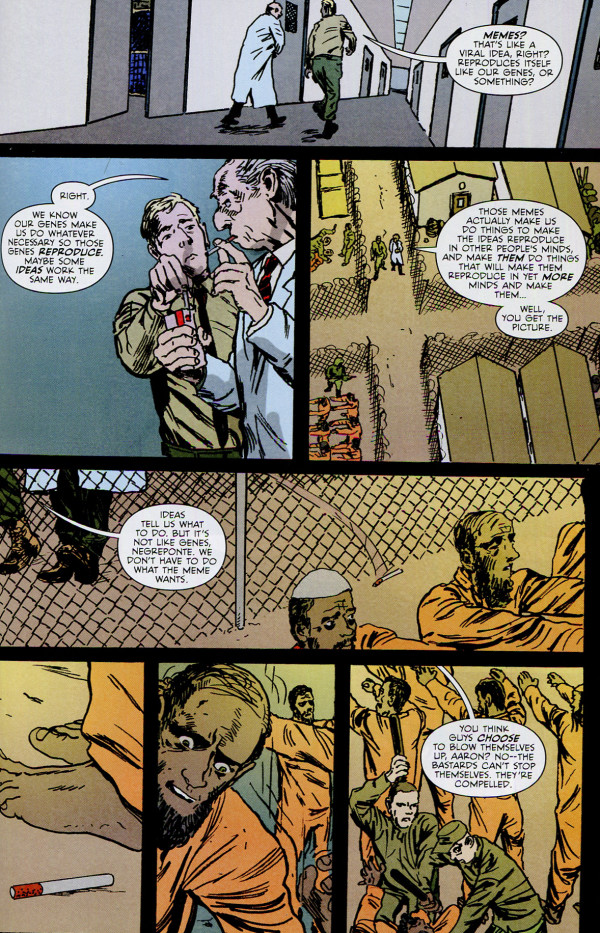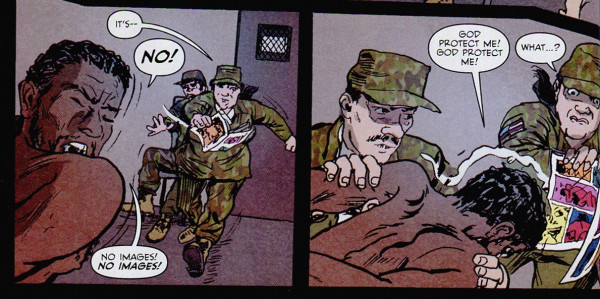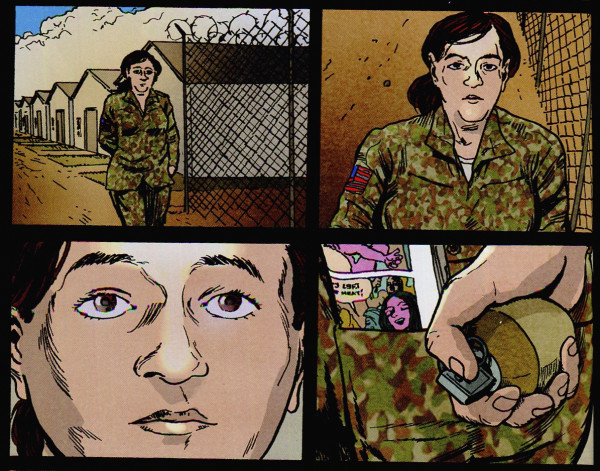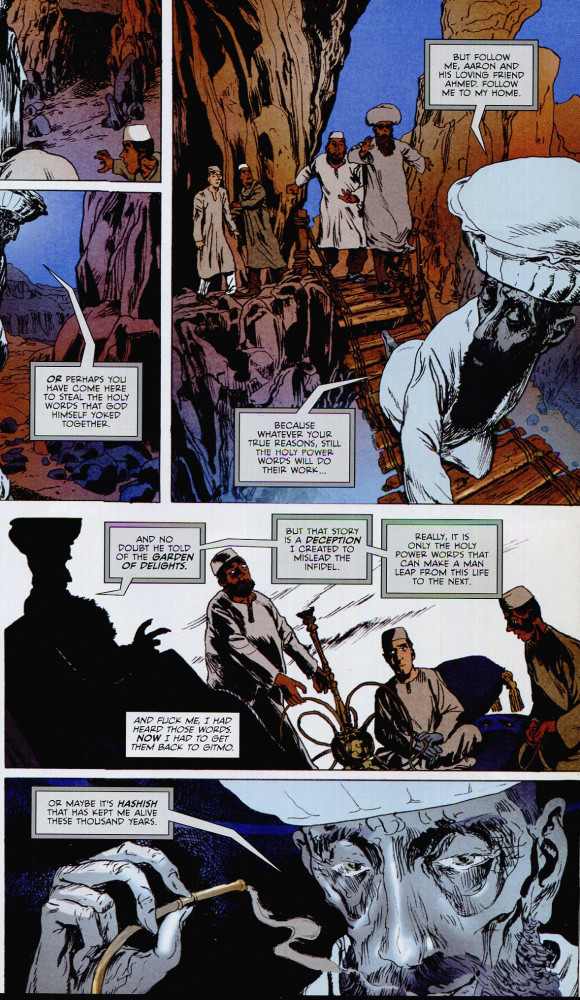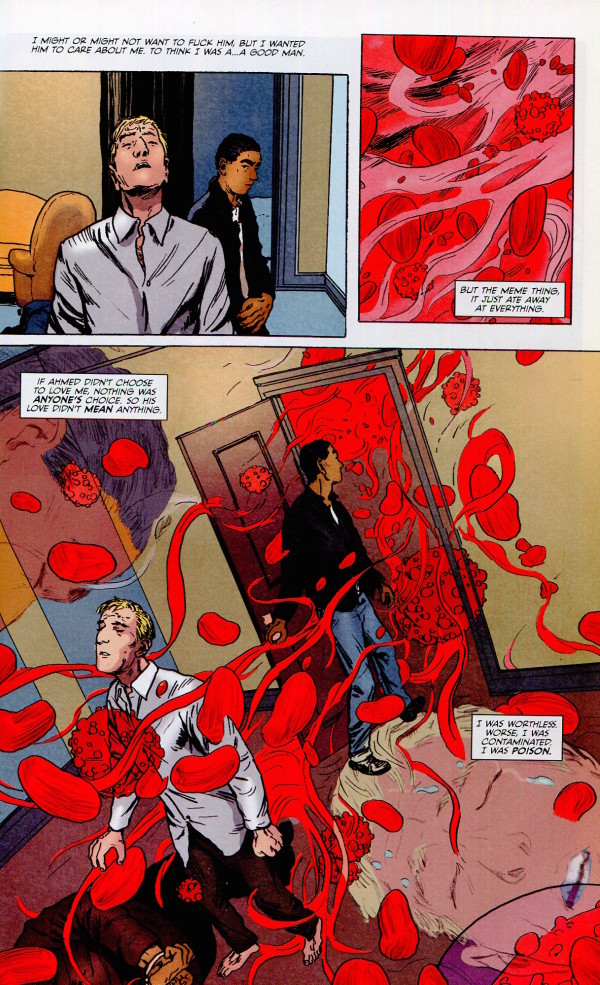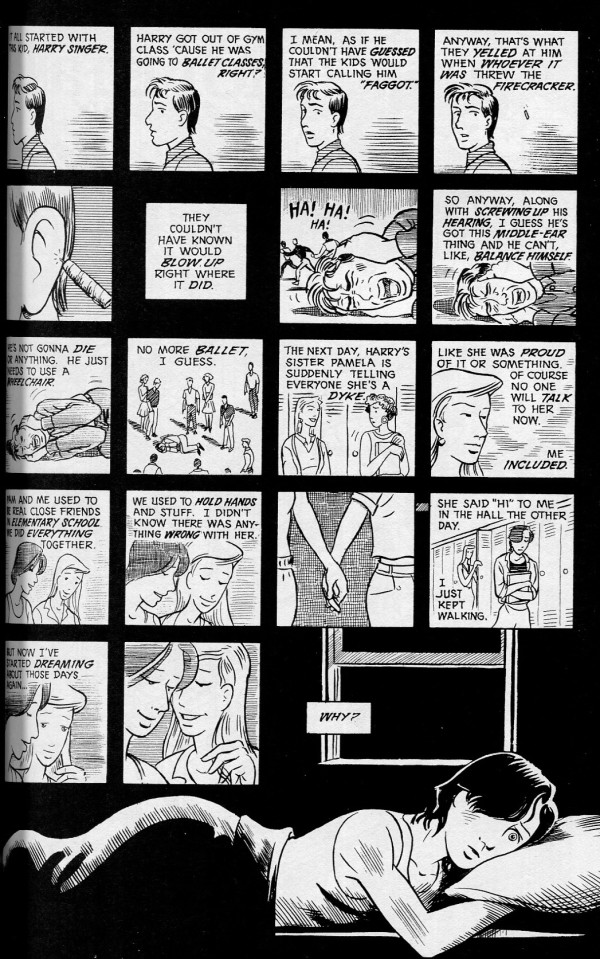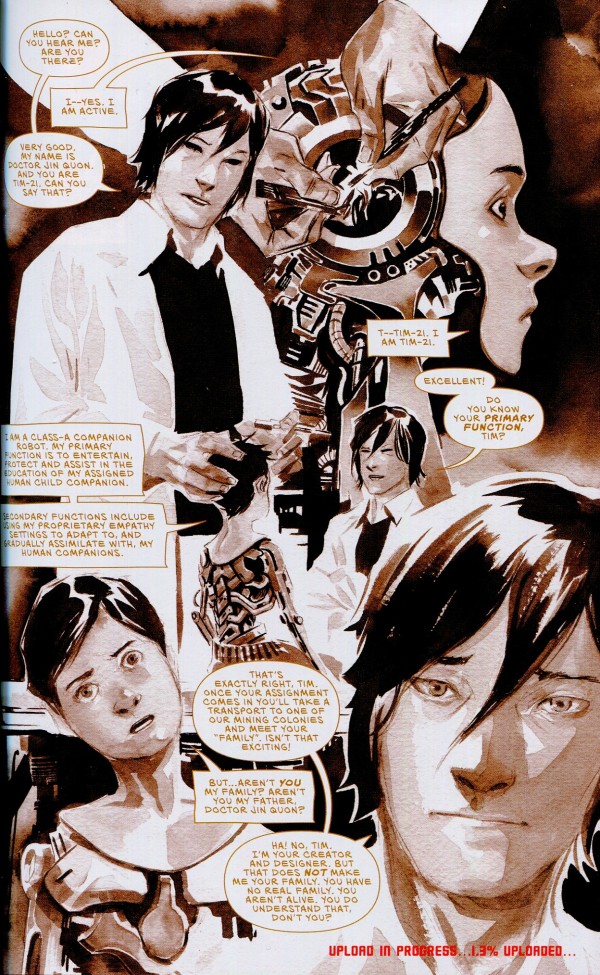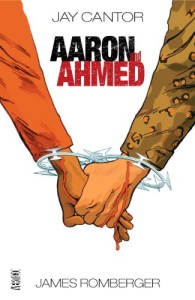 Aaron and Ahmed by Jay Cantor & James Romberger (Vertigo, 2011)
Aaron and Ahmed by Jay Cantor & James Romberger (Vertigo, 2011)
The PR line for Aaron and Ahmed, repeated in all its blurbs, is, “What causes terrorism?” It’s the starting point for the story written by Jay Cantor and drawn by James Romberger; the point-of-view character, Aaron Goodman, loses his wife in the terrorist attacks of 9/11. Aaron signs up to be an Army doctor and finds himself in Gitmo, working with another doctor who’s trying to find a root cause for terrorism no matter the cost.
Aaron begins holding private interview sessions with Ahmed, one of the prisoners, lacing his food with estrogen to create a romantic bond which, as far as I can tell, is not a real thing (except for that one attempt with Hitler). It’s a pop psychology, sci-fi departure from the serious and realistic material, and as strange as it is, it’s nowhere near as opaquely dumb as what follows.
Aaron’s superior decides that memes are behind terrorism—that the chanting of Muslim fanatics somehow infect the minds of terrorists with an idea virus that causes them to become suicide bombers. Aaron and Ahmed begin to trust each other, and Aaron decides that the only way to uncover the cause of terrorism is to travel with Ahmed to meet with a possibly mythical leader of Middle Eastern suicide bombers.
Without spoiling the ending, what follows is maybe proof of Aaron’s meme theory or maybe a psychological play on his damaged psyche after witnessing his wife’s death and the horrors of Gitmo. However, the narration, provided mostly by Aaron’s internal monologue with occasional incursion by the Old Man of the Mountain, focuses entirely on Aaron’s belief that he’s being taken over by the meme virus of terrorism.
It’s frankly obnoxious. Instead of exploring the real-life cultural, socioeconomic pressures exerted on the Middle East, Cantor’s script follows a white man’s sadness and his tragic struggle. It’s a version of Dances With Wolves, where the American soldier becomes an even better Muslim than his Muslim friend, being chosen over Ahmed to become a suicide bomber. The real-life catalysts of terrorism—oil wars, installed dictators, Cold War tensions—are mentioned throughout, but it feels like lip service in the onslaught of meme talk.
And it’s a strange thing, because another important aspect of the book is the power of words. Chants and prayers, in Cantor’s meme philosophy, are rhythmic deluges of words that infect those that hear them, turning them into suicide bombers. So using the meme narrative—using all the words in the comic to describe the sci-fi theory—in lieu of the more realistic possibilities is an odd choice. Is Cantor saying that only fantastical words can infect people with large ideas? That his meme ideas are akin to the prayers, and he’s hoping to infect us with his story?
Once a potential suicide bomber is infected by the chants of the Old Man of the Mountain, it takes an image to activate their programming. This is perhaps the most interesting part of the book since we’re dealing with a comic—a story that puts the lie to any kind of false dichotomy between image and picture.
Both Aaron and an unnamed prisoner talk about being activated by images, but a comic book also plays a big part in the plot. In possession of a jailer, it inspires soldiers to demean and abuse a prisoner. It’s taken away by one of the soldiers, though, and she scolds the others. Later on, she commits suicide with a grenade, effectively becoming a suicide bomber in the process, and her possession of the comic is repeatedly highlighted.
Maybe Cantor is trying to say that a comic—a potent combination of word and image—can mainline the meme infection. It only takes a few days for the soldier to go from paragon of her career, tempering the more violent soldiers, to suicide bomber. Is Cantor saying that comics are bad for people? Or is it just that we only see “bad” literature—trashy comics, fanatical chants—in action? (There is a small subplot where soldiers are reading “good” literature to prisoners in an attempt to counteract their programming, but that plot remains unresolved.)
A word on Aaron and Ahmed‘s images: they are the best part of the book. Romberger has been a great cartoonist for years, at least since his work on 7 Miles a Second (an intensely personal and apocalyptic book that faces contemporary issues in a way that puts Cantor’s script to shame). It’s Romberger’s art that makes the characters of Aaron and Ahmed actually feel like people; his soft, at times almost squishy anatomy balances out Cantor’s cold and clinical script.
Especially amazing are Romberger’s portrayals of the more fantastical scenes. Where Cantor’s script hammers at the sci-fi elements, Romberger’s drawings, such as of the Old Man of the Mountain and Aaron’s impending infection, are have a softer, subjective feel to them. They’re much more subtle than Cantor’s script, even at their most tortured and lurid. They’re helped, of course, by the balanced colors by José Villarrubia.
Cantor’s obsession with the interplay between words and images rings false in light of this book. It would have been much better as a wordless comic.
How about you, readers? Have you ever loved part of a book but hated another?
 Hav by Jan Morris (New York Review Books Classics, 2011)
Hav by Jan Morris (New York Review Books Classics, 2011)
This printing of Hav contains two of Jan Morris’s books, 1985’s Last Letters of Hav and 2005’s Hav of the Myrmidons. Together, they cover both of Morris’s visit to the titular Mediterranean city, a city that transcends its fiction to become real.
Hav is, on Morris’s first visit, a city just like any other: jumbled in geography and history and purpose. The land was originally settled by people known as the Kretev, an indigenous population possibly related to Celtic wanderers, possibly Greek. It was settled and colonized in waves by Greeks, Kurds, Crusaders, Russians, Chinese, a tripartite German/French/Italian force, and British. Modern-day Hav (in 1985, at least) is a mix of all these cultures.
Morris, as a travel writer, approaches the city with an open mind. She wants to know what it means to be Havian—what the Iron Dog statue really portrays, whether Hitler actually visited, where all the Hav bears are hiding out. And she actually finds some answers too: clear answers, obtuse answers, contradictory answers. It’s confusing. Take, for instance, the Iron Dog, a statue at the southern tip of the Havian peninsula:
It was not, when I reached it, how I had foreseen. From a distance, it looks all stark arrogance, its head held so high…but so relentless does it appear, especially in photographs, that some modern scholars have declared it to be not a dog at all, but rather the fox that young Spartans were supposed to take into the hills, to gnaw at their bellies and make men of them…But when you get close to the figure, such notions seem implausible. Whatever else he may be, the Iron Dog is certainly not a fox.
So a dog in name, a fox in photographs, but neither up close. He’s also bronze—not iron at all. One Havian says the dog is actually a dragon like the ones on the Ishtar Gate of Babylon. So it’s a Greek/Babylonian Iron/Bronze Dog/Fox/Dragon, depending on how you look at it, but however you try to classify it (and the classifications will surely change with time and viewer), the dog is there. It can be seen and touched.
The same is true of the people of Hav:
‘Do you really think your friend Mahmoud is an Arab? Some Arab! He’s no more Arab than Missakian’s Armenian!’
‘Missakian’s not Armenian?’
‘Of course not. He’s pure Greek, anyone can see that, like half the people in this place who call themselves Armenian, or Jewish, or Syrian…’
‘Dear God,’ I said to Magda one day, trying to assimilate all these confusions, ‘I don’t think I shall ever master the meaning of Hav.’
Morris discovers that it’s easiest to define things when they’re viewed from a distance—a fox in a photograph. But as you get close, as you put your hands around it, definitions get slipperier. Because even if you call Missakian a Greek, what does that mean? Look closer: Greece was a collection of culturally different city states, and it was ruled by Romans and Turks and inhabited by traders from around the world. Calling a Havian Greek is like saying a mixed thing is a mixed thing, and in Hav (and in the rest of the world), everyone is a mixed thing.
But Morris is okay with this. It’s the charm of a city, and it’s the charm of a person. How do all these pieces interact and change each other and change us? It’s okay to have definitions slip through your fingers. It’s okay not to know.
When Morris returns in 2005, however, Hav is much changed. Shortly after her first trip, there was an Intervention—an attack by black planes and warships. Much of Hav was razed, but it’s been rebuilt and is now governed by a Cathar theocracy. They believe they’re descended from Achilles’s Myrmidon soldiers, and they’re unifying Hav in their name.
So Hav of the Myrmidons, in stark contrast of old Hav, only has one history: it was started by the Myrmidons, and although it has been conquered and diluted, the Myrmidons, by way of the Cathars, rule it again.
But it’s a false history. The Myrmidons, magically evolved from ants, weren’t real. Hav’s unification only happened due to a fictional narrative being wielded as a blunt force tool. The Cathars have smashed Hav into shape with a story. Those bits of life that don’t agree with the story—the Kretevs, the Arab call to prayer, and the messy, mixed neighborhoods—are all hidden away or cleaned into nothing.
But who are the Cathars? They’re a heretical religion similar to Manichaeism: they believe in dual forces that rule the universe. Where Hav was multitudinous, Catharism is two; where Hav was messy, Catharism is clear.
(And there are hints that the leaders of the Cathars are an older generation from the Athaeneum, the center of learning on old Hav. Leave it to the old academics to demand definition at the cost of diversity.)
The fact that the destructive event is known as the Intervention is telling. It could have been called the Battle, the War, the Blitz, the Strike, but Morris chose a somewhat neutral, almost bland term. And where a War would implicitly have two sides, an Intervention is what you do when someone does something wrong. It’s how you get a messy person to clean up their life. One has to assume that the Intervention was part of the Cathars’ plan to get Hav in line.
Morris isn’t allowed to stay long on her second visit. After just a few days, she’s forcefully hustled onto a plane. Is her life too messy for Hav of the Myrmidons? She was divorced from her wife after having five children together, only to be later reunited in a civil partnership. She’s Welsh but British. She served in World War II but helped opposed the Falklands War. And she had to travel all the way to Morocco for sex reassignment surgery because British doctors refused her. Like every real person, Morris is too messy for the streamlined fiction of Hav.
And that’s the scary part of Hav in 2005—its loyalty to its own fictions, even over the happiness, wellness, and very lives of its citizens, is reflected in the national narratives of countries all over the world. It’s the kind of story that makes people think it’s okay to build walls on their borders and to assume that countries only belong to people of one skin color.
Readers, are there books that help you make sense of a messy subject? And are there books that frame complicated situations too tritely?
My reading habits have been sporadic and random lately. I’m like a springtime forager just eating whatever blooms and stalks I see after a winter of being too busy to choose my reading carefully.
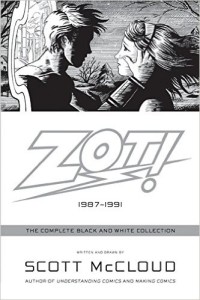 Zot! The Complete Black and White Collection by Scott McCloud (Harper, 2008)
Zot! The Complete Black and White Collection by Scott McCloud (Harper, 2008)
Zot! is the comic that probably put Scott McCloud, famed comics scholar, on the national map. It was his longest fictional work, and it was completed as he was starting Understanding Comics, the first of his books about comics as an artform.
I confess to an inflated expectation, then, in regards to McCloud’s formative work—would it employ all of the formal tactics he codified in his critical writings?
The answer, surprisingly, is yes. Zot! has great pacing and playful structuring, often breaking the narrative into interesting slices of time and point of view:
Unfortunately, the story that these tricks serve vacillates between bland and melodramatic. It follows teen science hero Zot, paragon of a parallel Earth, and his romance with pessimistic Jenny, stuck in our humdrum world. Her negative outlook is only exacerbated by knowledge of Zot’s fantastic utopia, and the tension in their relationship comes from her desire to escape her everyday life and Zot’s insistence that any world, any culture, is beautiful and worth saving. It’s a good starting point, but it often boils down to Jenny yelling or weeping while Zot looks on stoically. His childish naiveté fits his character, but it also means that no one really tells Jenny why leaving the less lucky of her world for the fantastic sci-fi life would be a gross exercise of her privilege.
McCloud himself notes that some of his morals come off a little heavy-handed, comparing them to afterschool specials. This sentiment is coupled with a dismissive attitude toward the superhero aspects of the story, namely Zot and his super-science. However, the exceptionally melodramatic aspects of the series only get worse as Zot’s world is phased out and McCloud focuses on the everyday.
It turns out that when a kid is flying around with a laser gun and rocket boots, it’s easier to mythologize the story—since there are aspects that readers know aren’t real, it can be fun to draw parallels and assign allegories to the cast and the story. When McCloud decided to take things in a “literary” direction, his characters and dialogue began to crumble under the weight of the issues he was tackling. Maybe the problem lies in writing toward those said issues—crime, coming out, divorce—instead of focusing on the characters.
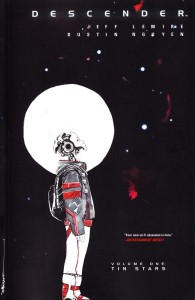 Descender: Tin Stars by Jeff Lemire and Dustin Nguyen (Image Comics, 2015)
Descender: Tin Stars by Jeff Lemire and Dustin Nguyen (Image Comics, 2015)
As a standalone volume, Tin Stars wasn’t great. It introduces a futuristic sci-fi galaxy that hates robots after a mysterious mechanical attack. One of the last robots, a boy-shaped droid named Tim-21 who was made for friendship, might have connections to the event that kicked off the robot genocide. He and his dog-bot, then, are on the run from two factions in the galactic government. Who will catch him? Are their intentions what they seem? And what is Tim-21’s link to the giant robots that have irrevocably damaged galactic culture?
By the end of Tin Stars, I found myself not really caring about the answers to these questions. Nearly all of the characters felt like bland stereotypes: the naive artificial boy looking for his human friend, the cute animal sidekick, the soldier woman with something to prove, the deadly thug with a heart of gold, the pig-like villains with no morals—it felt like an outline for a summer blockbuster. It didn’t help that the book was riddled with typos, from misspelling characters’ names to freely swapping out exclamation points and question marks.
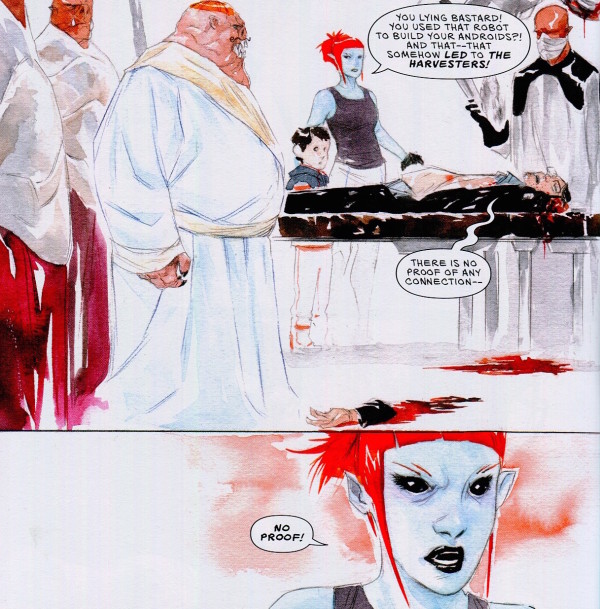
I’m 99% sure she’s doubting his statement, but with that exclamation point, she could be vehemently agreeing.
Future volumes might develop these characters more. Indeed, the one character who gets an extended flashback, Dr Quon, becomes an interesting, flawed, and driven guy once his secrets are exposed. I’m just not sure I’m ready to wade through the typos and stereotypical dialogue to reach that point.
It’s too bad, too, because the art by Dustin Nguyen is beautiful. He makes even the most cluttered pages readable, and he uses spare brushstrokes that convey a surprising amount of information. His designs and facial expressions do a lot of the heavy lifting in the character development department.
The story reads fast enough that a collection of 10 or 12 issues wouldn’t have been intimidating. If the characters get some development in the next few chapters, I’d have happily kept reading. Are these things considered by collection editors?
 The Autumnlands: Tooth & Claw by Kurt Busiek, Ben Dewey, and Jordie Bellaire (Image Comics, 2015)
The Autumnlands: Tooth & Claw by Kurt Busiek, Ben Dewey, and Jordie Bellaire (Image Comics, 2015)
All I knew about this comic going in was that it was about animal people. On that level, it did not disappoint. In fact, the book did not disappoint at any level.
Despite having a cast of dozens, Busiek and Dewey use an inseparable combination of character design (animal choice, clothing, posture) and dialogue to establish personality and motivation quickly and firmly. The world—a place of dying magic, floating cities, and aristocracy and oppression—is explained at a natural pace.
Some fantasy and sci-fi can feel like being led through a museum of the creators’ ideas; their worlds are static, relayed through bursts of exposition. This is not the case with Autumnlands. These toys aren’t precious to their owners, and they’re freely deconstructed, deposed, and disposed of. There’s a central conceit to the story—a sci-fi twist to the Wizards of Redwall status quo that I hesitate to spoil—is almost just set dressing for the drama and politics of the rest of the book.
Dewey’s art is slick and clear with lush ink work, and it’s impossible to talk about it without mentioning Jordie Bellaire’s color. There are a lot of sepias and earth tones, but it’s far from muddy; Dewey’s sharp lines keep things clear, and Bellaire uses splashes of bright color for the rich clothing, magic spells, and (spoiler warning) blood.
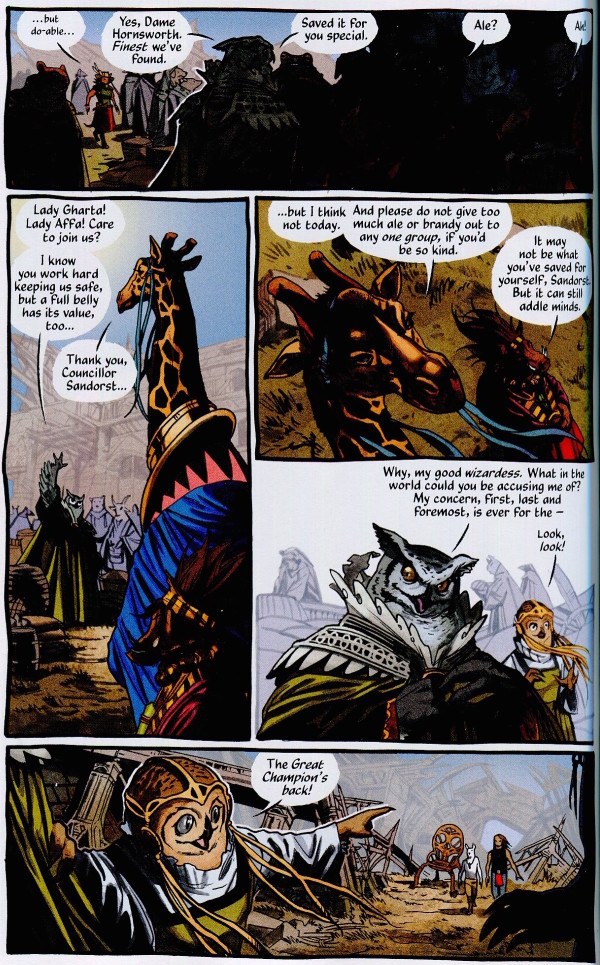
The evil character at the top is surrounded by inky darkness that slowly gives way to browns and then bright colors as the hero returns.
How about you, readers? What do you read when you’re grazing? And do you regret those choices later?
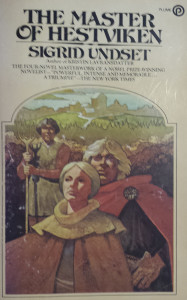 The Snake Pit by Sigrid Undset (Vintage, 1926/1994)
The Snake Pit by Sigrid Undset (Vintage, 1926/1994)
Maybe I’m just Baader-Meinhofing, but I’ve seen numerous complaints of a lack of criticism of older work. It’s easy enough to find recommendations for contemporary books, even if they’re not huge bestsellers, but what if one is curious about an old used paperback?
Case in point: my copy of The Master of Hestviken (of which The Snake Pit is the second book of four) by Sigrid Undset. The spine is ragged, the colors are faded, and the back cover copy is vague. Its Wikipedia entry doesn’t even have a plot summary.
Undset, though, is far from an unknown. She’s a Nobel laureate, she has a crater on Venus named after her, and her trilogy Kristin Lavransdatter is well-known; it was given a new English translation as recently as 2005.
The lack of love for The Master of Hestviken, then, is a mystery. It’s most recent translation appears to be from 1994. Maybe it’s the length of the book? It’s a tetralogy, compose of The Axe, The Snake Pit, In the Wilderness, and The Son Avenger. Confusingly, they have been printed separately, in pairs, or as a single book.
Or maybe the historical context makes the book seem daunting. It’s set in 13th-century Norway during a time of civil war, and while it’s not about the war, the flurry of faction names, rulers, and family connections can be difficult to keep track of.
But I’m here to dispel that worry. The Master of Hestviken, specifically The Snake Pit, is a human novel about failures, secrets, and the inability of speech to bridge the gap between intention and impact.
The book begins with Olav Audunsson’s assumption of the titular position as master of Hestviken, his ancestral estate. His wife, Ingunn Steinfinssdatter, soon joins him, and they set about turning the decaying estate into a family home.
However, both have secret serpents eating at their hearts. Ingunn had a son out of wedlock. The boy is the product of violent rape, but Ingunn is too ashamed to reveal that fact, not even to Olav. And Olav killed the man—in his mind, a seducer but nothing more—and bears the guilt of not confessing or reporting the murder, not even to Ingunn.
The process of learning to live together, then, becomes a slow, strange dance in which the married couple keep each other at an estranged distance buffered by secrets and lies. Events that loom huge in their minds, that inform everything they do, remain unknown outside of their heads, making their actions seem puzzling at best and incomprehensible at worst. And Olav and Ingunn both suffer.
Ingunn’s suffering is most obvious—she is literally wasting away. She and Olav try over and over to conceive a child, and each is stillborn or dies young. Ingunn feels bits of herself drift away with each failure, blaming herself and her body. She has weeping and fainting spells, she can’t concentrate, and she’s frequently sick. A reader might call it PTSD, but we have the benefit of modern medicine, and we know what Ingunn has been through. To the other characters in the book, though, not privy to the violence enacted by rapist Teit Hallsson, Ingunn is a weak and fay creature who can’t do what a wife is expected to do: bear children and keep house.
Olav’s suffering leads to social ills. The men he turns to—surrogate fathers from the church, his adopted family, and neighboring houses—all die or leave or misunderstand his needs as he tries to confess what he views as a damning sin. And so Olav closes up, too afraid of judgment to reveal what would most likely viewed as a blameless act on his part. His neighbors and extended family begin to view him as a dour and severe man, which only causes him to draw back even more.
This chorus of gloom and doom, the constant and naturalistic grinding away of the characters’ selves, is punctuated by selfless acts of love. They range from small concessions to life-changing ones—Ingunn’s continued attempts to cook, Olav’s adoption of Eirik (Ingunn’s daughter by Teit). But it’s difficult to know if these acts are enough—enough to show affection in spite of looming secrets, enough to balance out the misunderstandings of a tight-knit, newly Christian society?
The entire book is a push and pull between the consequences of speech (which is almost guaranteed to be misunderstood or tinged with anger and sadness due to the characters’ histories) and the consequences of silence.
For instance, upon returning home from a time at sea, Olav kills a lynx on their land. What follows is an exchange between Olav and Ingunn regarding how Olav treats Eirik:
“If you gave Eirik the fairest colt ever bred—with saddle of silver and bridle of gold—what would that serve, Olav, if you cannot alter your feelings—can never look at the boy without a grudge?”
“That is not true,” said Olav hotly. “You are heavy too, you sow of Satan”—he had got the lynx on his spear and hoisted it over his shoulder.
It’s a shocking moment where, for only a second, a reader has to wonder whether Olav is calling Ingunn a heavy sow. It replicates what Ingunn must feel, and even after she and the reader realize Olav is talking about the lynx, the wound of the perceived insult would linger.
Undset’s prose is terse and minimalist, drawing from the Norwegian and Icelandic sagas. Using such straightforward prose to explore the emotional depths of her protagonists leads to a formal echoing of the tensions between those protagonists. It’s like Virginia Woolf, if Virginia Woolf wrote about the consequences of late Medieval revenge slayings.
Undset’s place in the canon—of literary writers, of saga-style writers, of Norwegian authors—was more than secure on the basis of Kristin Lavransdatter. The Master of Hestviken cements that place even further, and it has me hungry for her other works. It also makes me curious about that entire strata of authors who are less-than-household names in America but have earned a measure of success and recognition abroad. How much am I missing out on?
Readers, who are your favorite authors that don’t get the recognition they deserve? And what are their lesser-known works that we should be reading?

